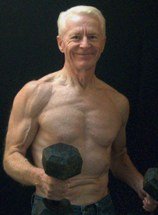


In today's Dec. 15, 2011 newsletter . . .
Exercise Volume (Part 2): Realistic GuidelinesOff and on, I have lifted weights or practiced martial arts most of my life. I was never exceptional at doing either one, but did reasonably well and could hold my own.As I grew older, I pushed myself pretty hard for as long as I could. However, by my late 50s I often had to coax myself out of bed in the morning following a session of sparring or grappling; and I began having low-back pain. I would rest until it felt better, and then I’d go back for more, with the same result. It isn't that uncommon. Hang around any gym and you find guys doing what I did. They are basically fit, but stubborn about making adjustments in their training. Eventually, I “listened to my body,” as they say, and made age appropriate changes. I still trained with weights, of course, but switched from martial arts with contact to leading cardio-kickboxing classes, where you go through some fighting motions but no one hits back or tries to bend you like a pretzel. It was great fun and a good workout. Then in my late 60s, I began experiencing some shoulder pain following resistance training; a couple of times it was painful enough to take a cortisone shot. Just as I had done with martial arts practice, I would work around the pain until things felt normal again, and then return to the same routine. And as night follows day, my shoulder aches would return. Finally, rational thinking -- and nagging shoulder aches -- overcame my stubbornness; I began looking for what it was, exactly, that my rotator cuff disliked about my training. It turned out to be the bench press. I tried switching from barbells to dumbbells, changing the angle of the bench, and, finally, using weight machines. A couple of the adjustments helped somewhat; but in the end I found out the bench press, in any form, seemed to cause me more trouble than it was worth. Strangely, though, I found I could do various types of push-ups, even with weights on my back, without it bothering my shoulders. I’ve been doing them ever since. Aside from the aforementioned realities of aging, I was able to maintain my strength and pace throughout my 50s and 60s. As I entered my 70s, however, I began to notice that I needed more rest than before, and that I had to ease up in training. Overdoing it is much too common at any age, but the consequences can be particularly problematic for seniors. Here are some workout guidelines that should help seniors stay strong and fit and out of trouble:
Train for your whole life. But for lasting strength and longevity, stay within realistic guidelines. You've probably heard about the tremendous benefits of weight training and how you can retain -- or even reclaim -- the attributes of youth . . . Discover the way with . . . Gray Iron: A Fitness Guide for Senior Men and Women

Newsletter Policy The Gray Iron Fitness Newsletter is a free publication sent twice monthly to subscribers. The purpose is to provide honest and realistic fitness information for people age 50 and above. I have never been paid or received compensation of any kind to write a positive review or endorse a product. If I say that I personally use a product or service, it is because I find value in it and have paid for it with my own money. Like newspapers, magazines and television, this newsletter and my web site contain advertising and marketing links. Naturally, I am compensated for these. The newsletter and web site provide information to help users establish and maintain a fitness lifestyle. But fitness information is not the same as fitness advice, which is the application of exercise and dietary practices to an individual's specific circumstances. Therefore, always consult with your physician for assurance that fitness information, and your interpretation of it, is appropriate for you. Your comments and questions are always appreciated. Sincerely, Logan Franklin The Gray Iron Fitness Newsletter www.senior-exercise-central.com |